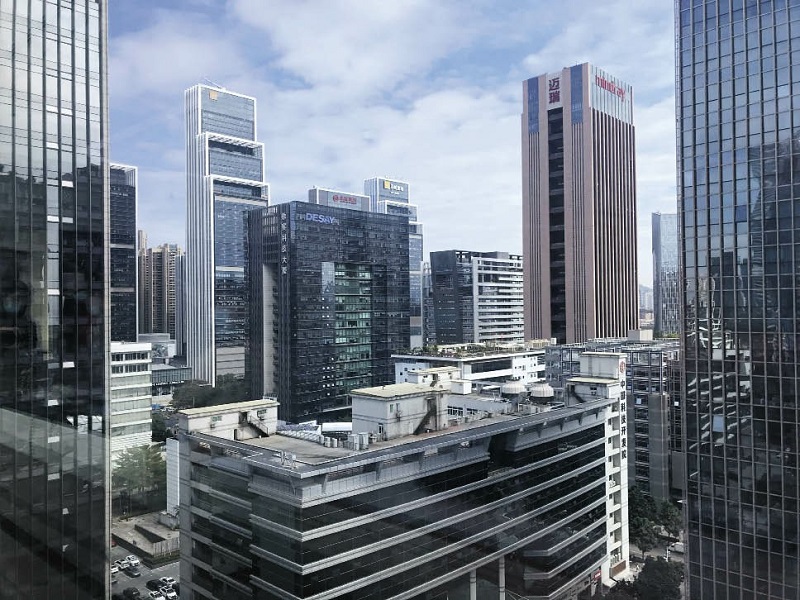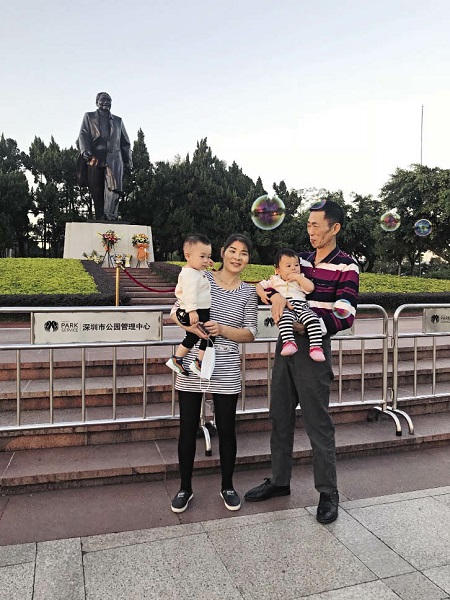From a quiet fishing village to a modern hi-tech metropolis − the Cinderella fairy tale in Shenzhen never ceases to amaze everyone who has been there. Where once 30,000 rural people went about their basic daily lives in the small county seat of Bao’an, today shiny glass office towers kiss the clouds and innovative people chase the Chinese dream.
During the following years, Shenzhen was primarily a magnet for the manufacturing industry, thus dubbed as the world factory. But that was in the past. Today, the metropolis of 13 million people at the doorstep of Hong Kong is not only one of the fastest growing cities in the world, but it has also become a global center for the electronics and communications industry. Furthermore, in 2008, Shenzhen became the first Chinese city ever to become a UNESCO City of Design and thus part of the Creative Cities Network. Shenzhen is now a metropolis of innovators and inventors, and of innovations and ideas.
I myself come from a medium-sized German city not far from Frankfurt. I’m almost at the same age as the city Shenzhen. However, I have not seen much change happen over the four decades in my German hometown as I still roam almost the same streets; while in Shenzhen everything seems new and many things are still in transition.

One of China’s first special economic zones, Shenzhen, within a span of 40 years, has grown from a small fishing town into a modern metropolis featuring a skyline of high-rise skyscrapers, intent on bringing more innovations to its home country and the rest of the world.
A Pioneering City
Then what has driven the vibrant metropolis all these years after the advent of reform and opening-up? What spirit is flowing through this coastal city, making it a driving force for technical and cultural innovation at the beginning of the 21st century, not only in China but also worldwide? With these questions in mind, I set off for Shenzhen looking for answers.
Even the majestic tower of the Ping’an International Finance Center has only been standing in Shenzhen since 2017. With its dizzying 599 metres, the building is the second highest skyscraper in China, after the famous Shanghai Tower.
Han Wangxi, director of the Publicity Department of the CPC Shenzhen Municipal Committee, said: “The development process of a city ultimately shapes its mentality.”
“In the case of Shenzhen, this mentality has been shaped to a large extent by the country’s reform and opening-up drive and by its status as a special economic zone. Over the past 40 years, many new ideas and concepts have manifested themselves here in Shenzhen, embedding themselves in people’s minds, like ‘time is money’ or ‘efficiency is the paramount.’ We believe here that empty words are only a hindrance to development. You have to have the courage to be a pioneer and achieve new breakthroughs,” said Han.
The fact that Shenzhen is still undergoing rapid change has something to do with its history of change and the culture of change that has taken root over the years. “Over the decades, more than 1,000 measures have been tested in Shenzhen for application throughout China,” said Han, adding that Shenzhen has done courageous pioneering work in many areas that shapes the spirit of the city today.
Nurturing Innovative Start-ups
The best symbol of this spirit is undoubtedly the company Da-Jiang Innovations Science and Technology (DJI). It was founded in 2006 by a young university graduate in Shenzhen. From a garage start-up to a global market leader − it is an astounding success story.
Together with a few fellow students, DJI founder Frank Wang was already working on remote-controlled flying drones that could stay stable in the air when he was at university. After years of development in a small Shenzhen storeroom, the young men finally achieved the technical breakthrough they had dreamed of. Today, DJI is setting standards worldwide when it comes to the technology for controlling camera drones.
Meanwhile, the devices are not only used by amateur photographers and professional filmmakers, but also, for example, employed in agriculture and in disaster relief operations. DJI has paved the way for a whole new industry with its technology and today leads this industry worldwide. For Xie Tiandi, head of DJI’s PR department, it is no coincidence that one of the first technical world market leaders in the 21st century nurtured by China comes from Shenzhen.
“Innovation is not produced by capital. It needs a sound environment,” said Xie, who himself has lived and worked in Shenzhen since 2012. “Here in Shenzhen there are many people who work on their own projects purely out of interest. Out of an enthusiasm they tinker with things and try out ideas, regardless of whether these will become profitable products or not,” he said.
While elsewhere it is often all about making a quick buck, a different wind is blowing in Shenzhen. “The city creates an environment in which, as a young person, you can afford not to look for immediate profit, but to try out exciting ideas until one day one of them might work,” said Xie.
The fact that such an environment exists in Shenzhen is also due to encouraging policies. The municipal government supports start-ups with well-directed support measures and tries to make it easier for young people to enter working life. In this way the local government hopes to attract talented people from all parts of the country and even from abroad.
“In 2019 alone, Shenzhen provided subsidies of more than RMB 28 billion for start-ups and the development of new businesses,” said Han Wangxi, adding that diverse cultural influences come together in the city, which ultimately enables the birth of new ideas. This applies to technical as well as cultural innovations.
A Supporting Government
In this context, the new possibilities of the Internet are increasingly tapped in the field of city administration to make living and working in the metropolis even more comfortable. One example is the free app called “I Shenzhen,” which was launched in January 2019. The municipal government commissioned the insurance, finance, and technology giant Ping An Insurance Group to develop it.
A total of 40 municipal departments now offer their services online via the new service app. More than 7,700 administrative procedures can be conveniently handled via the Internet, without tiresome visits to the related agencies and time-consuming queuing. Especially in times of COVID-19, the new platform has made many things easier and safer in the metropolis.
“More than 96 percent of personal and more than 70 percent of business services can be handled online via this app,” said Wayne Hu, deputy director of Ping An Smart City Technologies.
That governmental organs of Shenzhen do not think in rigid bureaucratic categories but look for viable solutions is also confirmed by Shang Linlin, managing director of Fantawild Holdings, China’s industry leader in animated films and operator of numerous theme and entertainment parks throughout the country.
At Fantawild’s headquarters in Shenzhen, creative minds work on hi-tech entertainment products that have long since found their audience beyond the country’s borders. For Shang Linlin, Shenzhen is just the right place to spread creative cartoon stories from China to the rest of the world.
“We have already received many offers to move our headquarters to other cities,” she said, “but our roots are here in Shenzhen. We also think that the city is simply the best place for us. Shenzhen is a creative and innovative city, and innovation is a state of mind here. For a company like ours, which combines the latest technology with modern culture, creativity and innovation are essential factors. Shenzhen is very open, tolerant, and full of vitality.”
In 2007, the year of its foundation, Fantawild was initially faced with a problem, as business that combines cultural products and technology was still uncharted territory in China at that time. And accordingly, during the registration process with the municipal authorities, people were not quite sure how to categorize the company at first.
“We wanted to combine cultural products with hi-tech. At that time, however, different departments were responsible for these two areas. Actually, it was not even possible to register a company like ours on a regular basis. But then we explained to the authorities what exactly we wanted to do. In the end we were able to register our company successfully. In other cities, this would certainly have been much more difficult,” said Shang Linlin.
The dual strategy that the city government has been pursuing to date is very simple: allow freedom and at the same time offer assistance, said Wayne Hu of Ping An Smart City Technologie. “The government follows the principle of not interfering in business development when it is not necessary, in order to create the necessary freedom. However, if help and support is needed, companies can always turn to the authorities with all their queries,” said Hu.

Local people are taking a picture with the statue of Deng Xiaoping, the late Chinese leader reputed as chief architect of reform and opening-up, at the Lianhuashan Park, Shenzhen.
An Attractive City for Young People
Shenzhen seems to be a very attractive place for young people. If you walk through the city’s busy business districts in the morning, you will hardly meet anyone over 40 years old. Moreover, the majority of young people in the metropolis come from elsewhere, which is rather unusual for Chinese cities.
“The Chinese are traditionally very attached to their hometown and reluctant to seek their fortune elsewhere. Here in Shenzhen, however, we only have people who have left their hometowns to pursue their careers. These people bring with them great idealism and great ambitions to create something of their own professionally. They are all united by their great motivation to start a career here in Shenzhen,” said Wayne Hu. “And that creates a very special atmosphere,” he added.
“The fact that there are so many like-minded people also facilitates integration and strengthens the feeling of belonging,” Hu observed. Such categories as locals and foreigners fade away in Shenzhen, a city that has seen its population grow from 30,000 to 13 million in just four decades.
Xie Tiandi from the drone manufacturer DJI, who himself moved to Shenzhen from another place, is convinced that his personal development and the development of his company cannot be separated from the cumulative development of the city. “Thanks to the development of the past, new talents can easily find their teachers and the necessary inspiration here today to create new things themselves and to bring the current achievements a step further,” he said.
And so, in this young metropolis, the seeds of the future are already sown today and new technical inventions that could shape our tomorrow are being made. Just how far such new technology can ultimately change not only our everyday lives, but even our perception of the old familiar world has been impressively demonstrated by the Shenzhen-based DJI itself in recent years.
“Before the boom of photo and video drones, most urban buildings were known in 2D, in other words, from the perspective of the ground. The new generation is now growing up with 3D aerial images from above. Ultimately, this is changing the way we perceive the world and thus has a far-reaching influence on our culture. In the future, we can use the air as a resource to further expand our lives and our working environment,” said Xie.
It will be exciting to see how new technical innovations will broaden our horizons in the future. Some of them will certainly come from Shenzhen, a city of the future that has already inspired today’s thoughts.